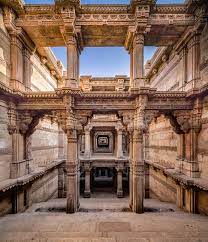The Adalaj stepwell or 'Vav', as it is called in Gujarati, is intricately carved and is five stories deep. It was built in 1498. An inscription in Sanskrit establishes the history of the Adalaj stepwell found on a marble slab positioned in a recess on the first floor, from the eastern entry to the well. Its construction was started by Rana Veer Singh of the Vaghela dynasty of Dandai Desh. But he was killed in a war, whereafter the Muslim king Mahmud Begada of a neighboring state built it in Indo-Islamic architectural style, in 1499.
The Sanskrit inscription in the stepwell describes,
Then follows a glowing description of the well, after which the queen, or rather lady of the chief, is praised in a few verses; the expense is stated at 5,00,111 tankas or over five lakhs, and the whole ends with a repetition of the date as given above.
The cultural and architectural depiction in the deep wells at various levels are a tribute to the history of step wells, built initially by Hindus and subsequently ornamented and blended with Islamic architecture during the Muslim rule.






No comments:
Post a Comment